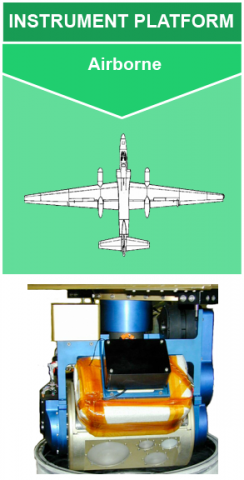 The NASA Global Hydrology Resource Center (GHRC) DAAC published the Conical Scanning Millimeter-wave Imaging Radiometer (CoSMIR) IMPACTS dataset. This dataset consists of brightness temperature measurements collected by the Conical Scanning Millimeter-wave Imaging Radiometer (CoSMIR) flown onboard the NASA ER-2 aircraft during the Investigation of Microphysics and Precipitation for Atlantic Coast-Threatening Snowstorms (IMPACTS) field campaign. IMPACTS was a three-year sequence of winter season deployments conducted to study snowstorms over the U.S Atlantic coast. IMPACTS aimed to (1) Provide observations critical to understanding the mechanisms of snowband formation, organization, and evolution; (2) Examine how the microphysical characteristics and likely growth mechanisms of snow particles vary across snowbands; and (3) Improve snowfall remote sensing interpretation and modeling to significantly advance prediction capabilities. CoSMIR is a conical and cross-track scanning radiometer with frequencies centered at 50.3, 52.8, 89.0, 165.5, 183.31±1, 183.31±3, and 183.31±7 GHz. The brightness temperature data from CoSMIR are available from January 15 through February 27, 2020 in netCDF-4 format. It should be noted that the ER-2 aircraft did not operate each day of the campaign, therefore CoSMIR data are only available for aircraft flight days.
The NASA Global Hydrology Resource Center (GHRC) DAAC published the Conical Scanning Millimeter-wave Imaging Radiometer (CoSMIR) IMPACTS dataset. This dataset consists of brightness temperature measurements collected by the Conical Scanning Millimeter-wave Imaging Radiometer (CoSMIR) flown onboard the NASA ER-2 aircraft during the Investigation of Microphysics and Precipitation for Atlantic Coast-Threatening Snowstorms (IMPACTS) field campaign. IMPACTS was a three-year sequence of winter season deployments conducted to study snowstorms over the U.S Atlantic coast. IMPACTS aimed to (1) Provide observations critical to understanding the mechanisms of snowband formation, organization, and evolution; (2) Examine how the microphysical characteristics and likely growth mechanisms of snow particles vary across snowbands; and (3) Improve snowfall remote sensing interpretation and modeling to significantly advance prediction capabilities. CoSMIR is a conical and cross-track scanning radiometer with frequencies centered at 50.3, 52.8, 89.0, 165.5, 183.31±1, 183.31±3, and 183.31±7 GHz. The brightness temperature data from CoSMIR are available from January 15 through February 27, 2020 in netCDF-4 format. It should be noted that the ER-2 aircraft did not operate each day of the campaign, therefore CoSMIR data are only available for aircraft flight days.GHRC News
 The NASA Global Hydrology Resource Center (GHRC) DAAC published the Conical Scanning Millimeter-wave Imaging Radiometer (CoSMIR) IMPACTS dataset. This dataset consists of brightness temperature measurements collected by the Conical Scanning Millimeter-wave Imaging Radiometer (CoSMIR) flown onboard the NASA ER-2 aircraft during the Investigation of Microphysics and Precipitation for Atlantic Coast-Threatening Snowstorms (IMPACTS) field campaign. IMPACTS was a three-year sequence of winter season deployments conducted to study snowstorms over the U.S Atlantic coast. IMPACTS aimed to (1) Provide observations critical to understanding the mechanisms of snowband formation, organization, and evolution; (2) Examine how the microphysical characteristics and likely growth mechanisms of snow particles vary across snowbands; and (3) Improve snowfall remote sensing interpretation and modeling to significantly advance prediction capabilities. CoSMIR is a conical and cross-track scanning radiometer with frequencies centered at 50.3, 52.8, 89.0, 165.5, 183.31±1, 183.31±3, and 183.31±7 GHz. The brightness temperature data from CoSMIR are available from January 15 through February 27, 2020 in netCDF-4 format. It should be noted that the ER-2 aircraft did not operate each day of the campaign, therefore CoSMIR data are only available for aircraft flight days.
The NASA Global Hydrology Resource Center (GHRC) DAAC published the Conical Scanning Millimeter-wave Imaging Radiometer (CoSMIR) IMPACTS dataset. This dataset consists of brightness temperature measurements collected by the Conical Scanning Millimeter-wave Imaging Radiometer (CoSMIR) flown onboard the NASA ER-2 aircraft during the Investigation of Microphysics and Precipitation for Atlantic Coast-Threatening Snowstorms (IMPACTS) field campaign. IMPACTS was a three-year sequence of winter season deployments conducted to study snowstorms over the U.S Atlantic coast. IMPACTS aimed to (1) Provide observations critical to understanding the mechanisms of snowband formation, organization, and evolution; (2) Examine how the microphysical characteristics and likely growth mechanisms of snow particles vary across snowbands; and (3) Improve snowfall remote sensing interpretation and modeling to significantly advance prediction capabilities. CoSMIR is a conical and cross-track scanning radiometer with frequencies centered at 50.3, 52.8, 89.0, 165.5, 183.31±1, 183.31±3, and 183.31±7 GHz. The brightness temperature data from CoSMIR are available from January 15 through February 27, 2020 in netCDF-4 format. It should be noted that the ER-2 aircraft did not operate each day of the campaign, therefore CoSMIR data are only available for aircraft flight days.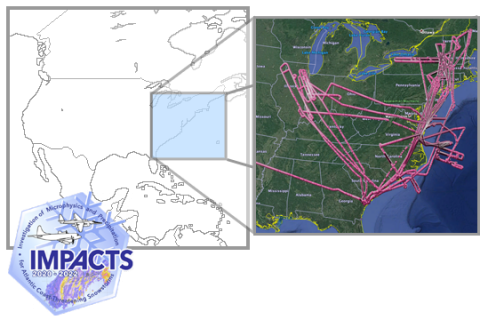 The NASA Global Hydrology Resource Center (GHRC) DAAC published the Investigation of Microphysics and Precipitation for Atlantic Coast-Threatening Snowstorms (IMPACTS) field campaign micro article. The IMPACTS field campaign, funded by the NASA Earth Venture program is the first comprehensive study of East Coast snowstorms in 30 years. This micro article provides an overview of Year 1 of the IMPACTS field campaign. This includes a brief description of the campaign, its goals, and important dates. The micro article also provides links to currently published IMPACTS data. The micro article will see updates in the future as new datasets are published and after the subsequent Year 2 and Year 3 deployments in 2021 and 2022.
The NASA Global Hydrology Resource Center (GHRC) DAAC published the Investigation of Microphysics and Precipitation for Atlantic Coast-Threatening Snowstorms (IMPACTS) field campaign micro article. The IMPACTS field campaign, funded by the NASA Earth Venture program is the first comprehensive study of East Coast snowstorms in 30 years. This micro article provides an overview of Year 1 of the IMPACTS field campaign. This includes a brief description of the campaign, its goals, and important dates. The micro article also provides links to currently published IMPACTS data. The micro article will see updates in the future as new datasets are published and after the subsequent Year 2 and Year 3 deployments in 2021 and 2022.
The micro article is available at: https://ghrc.nsstc.nasa.gov/home/micro-articles/investigation-microphysics-and-precipitation-atlantic-coast-threatening-snowstorms
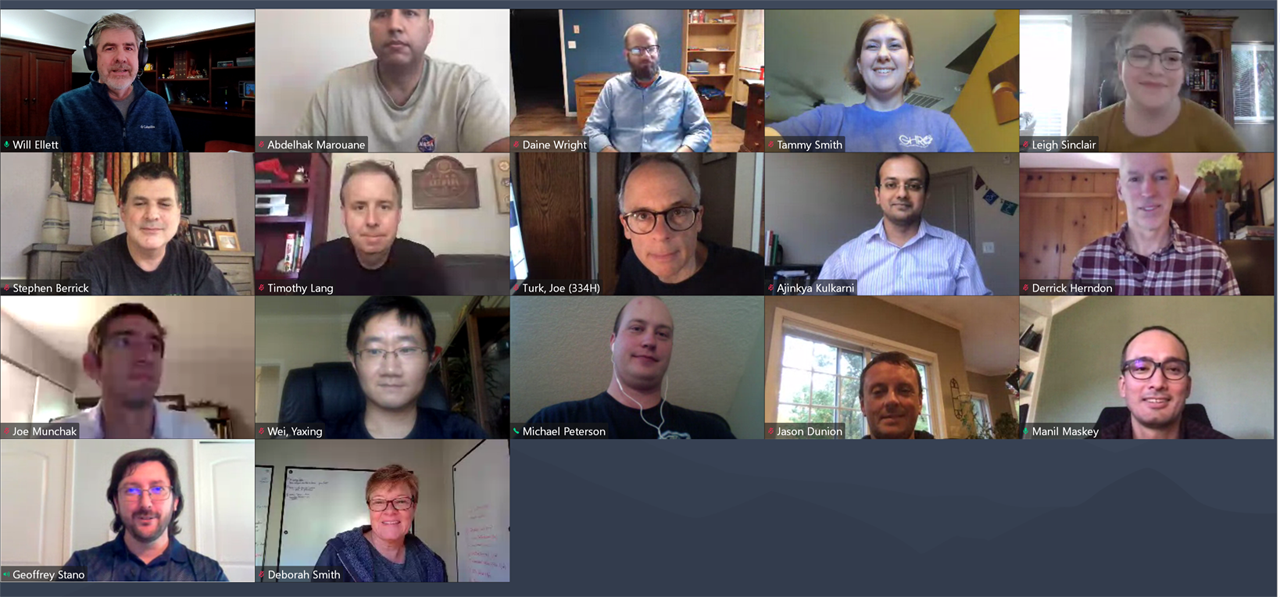
The NASA Global Hydrology Resource Center (GHRC) DAAC held its annual User Working Group (UWG) meeting on October 13-14. The UWG meeting is an opportunity for GHRC to showcase its accomplishments for the year, highlight new activities, and to receive feedback and guidance from both the UWG members and other attendees on how to best position GHRC for the year ahead. GHRC’s cloud transition featured prominently this year and covered GHRC’s data publications both on-premise and in the cloud, preparations for shifting to cloud-only applications, and highlighted GHRC’s NASA Group Achievement Award. A live demonstration of the publicly available Field Campaign Explorer was also provided (http://ghrc.earthdata.nasa.gov/fcx/index.html). Overall, GHRC’s efforts were well received and the feedback and recommendations by the UWG were positive. GHRC would like to thank all of our UWG members for their support and for the excellent discussions fostered by them and the attendees to the meeting.
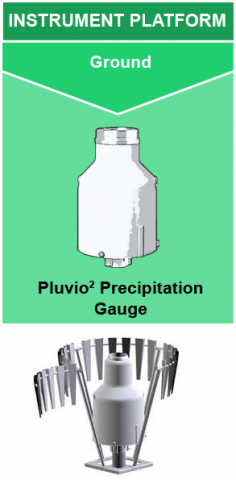
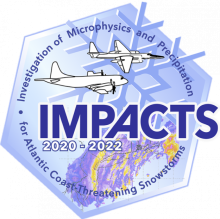 The NASA Global Hydrology Resource Center (GHRC) DAAC published the SBU Pluvio Precipitation Gauge IMPACTS dataset. This dataset consists of precipitation intensity and precipitation accumulation collected using the OTT Pluvio2 weighing rain gauge during the Investigation of Microphysics and Precipitation for Atlantic Coast-Threatening Snowstorms (IMPACTS) campaign. Funded by NASA’s Earth Venture program, IMPACTS is the first comprehensive study of East Coast snowstorms in 30 years. The campaign aimed to (1) Provide observations critical to understanding the mechanisms of snowband formation, organization, and evolution; (2) Examine how the microphysical characteristics and likely growth mechanisms of snow particles vary across snowbands; and (3) Improve snowfall remote sensing interpretation and modeling to significantly advance prediction capabilities. Data files in this dataset are available in ASCII-csv format from January 7, 2020 through February 27, 2020.
The NASA Global Hydrology Resource Center (GHRC) DAAC published the SBU Pluvio Precipitation Gauge IMPACTS dataset. This dataset consists of precipitation intensity and precipitation accumulation collected using the OTT Pluvio2 weighing rain gauge during the Investigation of Microphysics and Precipitation for Atlantic Coast-Threatening Snowstorms (IMPACTS) campaign. Funded by NASA’s Earth Venture program, IMPACTS is the first comprehensive study of East Coast snowstorms in 30 years. The campaign aimed to (1) Provide observations critical to understanding the mechanisms of snowband formation, organization, and evolution; (2) Examine how the microphysical characteristics and likely growth mechanisms of snow particles vary across snowbands; and (3) Improve snowfall remote sensing interpretation and modeling to significantly advance prediction capabilities. Data files in this dataset are available in ASCII-csv format from January 7, 2020 through February 27, 2020.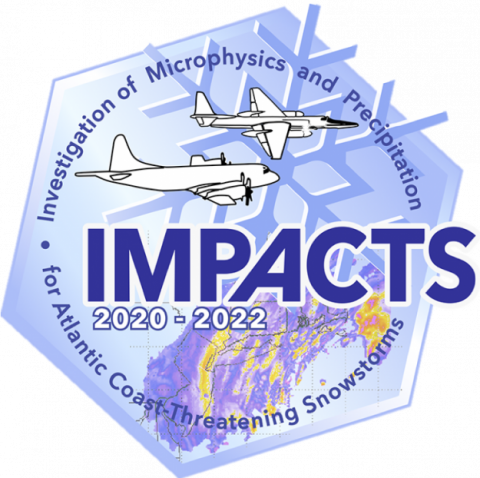 The NASA Global Hydrology Resource Center (GHRC) DAAC published the SBU Parsivel IMPACTS dataset. This dataset consists of precipitation data collected by the Parsivel disdrometer in support of the Investigation of Microphysics and Precipitation for Atlantic Coast-Threatening Snowstorms (IMPACTS) field campaign. IMPACTS was a three-year sequence of winter season deployments conducted to study snowstorms over the U.S Atlantic Coast (2020-2022). The campaign aimed to (1) Provide observations critical to understanding the mechanisms of snowband formation, organization, and evolution; (2) Examine how the microphysical characteristics and likely growth mechanisms of snow particles vary across snowbands; and (3) Improve snowfall remote sensing interpretation and modeling to significantly advance prediction capabilities. The Parsivel disdrometer data include particle size distribution, fall speed, radar reflectivity and precipitation rate. The dataset files are available in netCDF-3 format from January 1 through February 27, 2020.
The NASA Global Hydrology Resource Center (GHRC) DAAC published the SBU Parsivel IMPACTS dataset. This dataset consists of precipitation data collected by the Parsivel disdrometer in support of the Investigation of Microphysics and Precipitation for Atlantic Coast-Threatening Snowstorms (IMPACTS) field campaign. IMPACTS was a three-year sequence of winter season deployments conducted to study snowstorms over the U.S Atlantic Coast (2020-2022). The campaign aimed to (1) Provide observations critical to understanding the mechanisms of snowband formation, organization, and evolution; (2) Examine how the microphysical characteristics and likely growth mechanisms of snow particles vary across snowbands; and (3) Improve snowfall remote sensing interpretation and modeling to significantly advance prediction capabilities. The Parsivel disdrometer data include particle size distribution, fall speed, radar reflectivity and precipitation rate. The dataset files are available in netCDF-3 format from January 1 through February 27, 2020.





